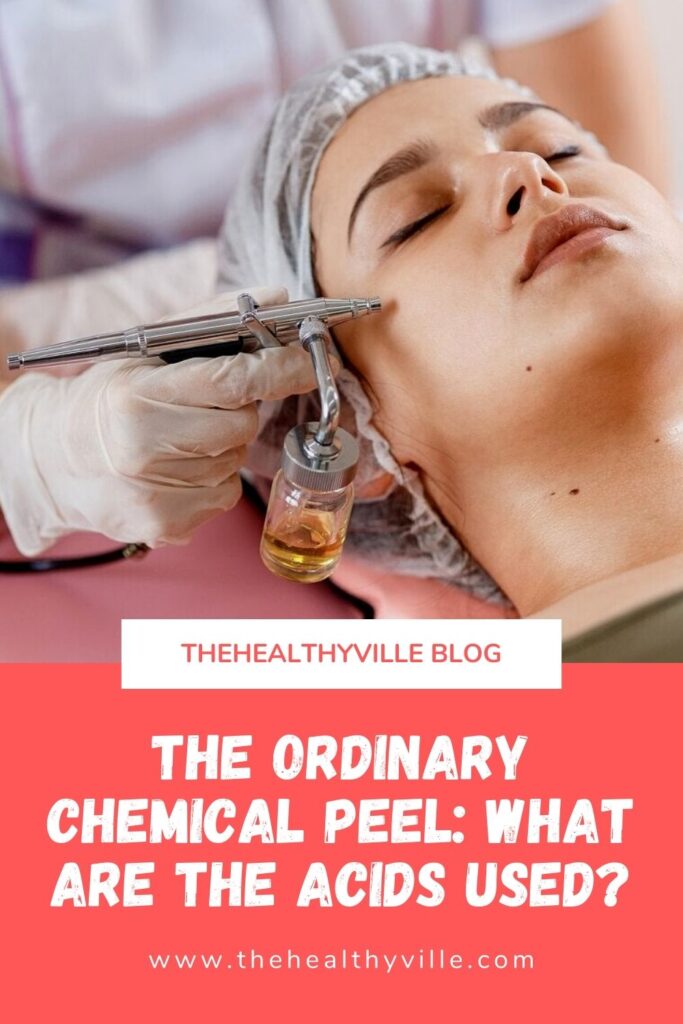The ordinary chemical peel is one of the most popular aesthetic treatments. It consists of a “controlled aggression” of the skin through the use of acidic substances. What are its benefits?
The chemical peel is also known by the name of dermabrasion. In recent years it has managed to position itself as one of the most widely used aesthetic procedures, since its application helps correct various skin imperfections.
In particular, it consists in the removal of a variable thickness of epidermis or dermis through the use of chemical substances that are generally acidic or caustic. With this, it is possible to renew the superficial layers of the skin to minimize the presence of spots, wrinkles, among others. You wonder, what are the most used acids in this treatment?
What are the acids most used in the ordinary chemical peel?
When carrying out the ordinary chemical peel, it is convenient to know that there are several types of acids to carry out the procedure. The choice between one or the other varies according to the needs of the skin. Therefore, before applying it, the ideal is to have the advice of a professional dermatologist. Let’s see in detail the most used substances.
Alpha hydroxy acids (A.H.A.As)
Alpha hydroxy acids (A.H.A.As) comprise a large family of compounds derived from fruits and natural substances. Due to their low toxicity, they produce almost no adverse effects and are easy to use.
Meanwhile, after the treatment, the person can resume their daily activities without problems. For this reason, it is one of the most popular chemical peels, both in offices and in home formulations.
These acids have the advantage that you can apply them to almost all skin types, regardless of age. Even, they get to adapt to all the phototypes. The best known in this category include the following:
- Malic
- Tartaric
- Citric
- Lactic
- Glycolic
- Kojico
- Ascorbic
- Mandelic
Because they belong to the same chemical “family”, they all share some properties, as well as possess distinctive individual characteristics.
Properties of alpha hydroxy acids
Some are used to perform a chemical peel, while others, which have a lower potency as an acid, are used as depigmentation agents or as supplements to other treatments. Specifically, they stand out for the following benefits:
Moisturizing power (hydro-retainer): they produce a softening effect and increase skin comfort.
Ability to regulate keratinization: they generate a moderate exfoliation and a renewing and “compacting” effect on the superficial layers of the skin.
Anti-aging effect: a publication of the journal Synthetic Chemistry and Natural Product Chemistry exposes that they attenuate small superficial wrinkles, reinforce the acidity of the epidermal superficial layers (which gives it greater defense against microbes), improve micro-relief and provide skin splendor.
Glycolic Acid
According to studies in Clinical, Cosmetic and Investigational Dermatology, it is most popular for its effectiveness and few adverse effects. Of all the acids, it is the one with the smallest molecule, so its penetration capacity is greater than other varieties.
They can have as good penetration as any other chemical peel, but scab, necrosis and peeling can be controlled and minimized if used in optimal conditions. Its main uses are as follows:
- Photodamage in general.
- Actinic keratosis.
- Solar lentiginosis.
- Acne and its aftermath.
- Post-inflammatory pigmentation.
- Melasma.
- Xerosis
- Ichthyosis.
- Follicular keratosis.
Mandelic acid
It is a derivative of bitter almond extract. A publication the Journal of Clinical and Aesthetic Dermatology determined that it is the alpha hydroxy acid most used for hyperpigmentation and acne treatments for its effectiveness.
Due to its origin from almonds, it has antimicrobial and antiseptic potential, so you can even use it as an oral medicine. It is especially indicated in people with melasma and acne spots. In addition, it is suitable for skin with rosacea or sensitivity.
The normal effects during the application of alpha hydroxy acids are burning sensation, tearing, redness and whitening of the skin. It is used at 30 or 50% in the office and up to 12% in home formulas.
Beta hydroxy acids (B.H.A)
Beta hydroxy acids (B.H.A) are a small group, of which salicylic acid is in common use in dermatology and aesthetics. In aesthetic medicine, it is used in the office from 10 to 30%.
Salicylic acid
Salicylic acid has been used for many years for its keratolytic properties for topical use in treating problems of hyperkeratosis and peeling of the skin, such as dandruff, seborrheic dermatitis, ichthyosis, psoriasis and acne.
To be more exact, you can apply it for the following:
- Superficial acne scars.
- Active acne.
- Hyperkeratosis
- Dyschromias in general.
- Photoaging.
- Fine wrinkles.
Skin care after chemical peel
After each chemical peel, the skin may feel tight, tender, dry, and pink to red. The fact of removing one or more layers of skin cells, forces the body to start various processes aimed at regenerating the lost skin.
Emphasis should be on avoiding contact with the sun and the use of sun protection. The use of thin layer petroleum jelly or moisturizing creams favors a slight peeling and without feeling of tightness.
Despite their popularity, peels are not harmless, they can alter the color and texture of the skin and leave scarring aftermath. According to medical criteria, you can perform them at any age, but not if you’re a pregnant woman or an infant.
Don’t forget to SHARE the ordinary chemical peel benefits with your friends and family on your social networks!

